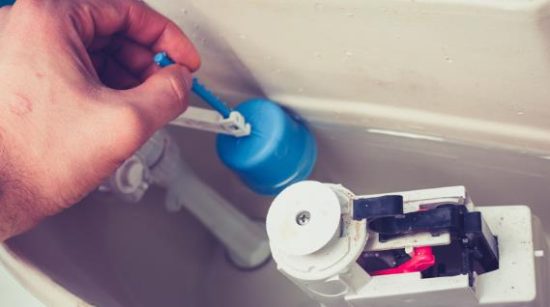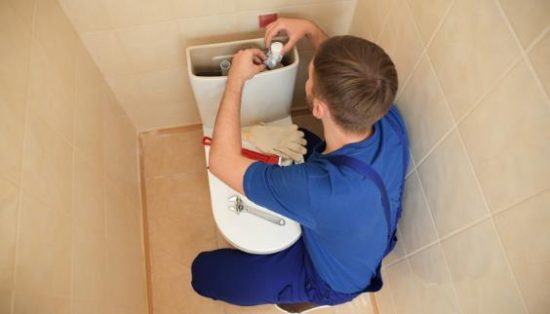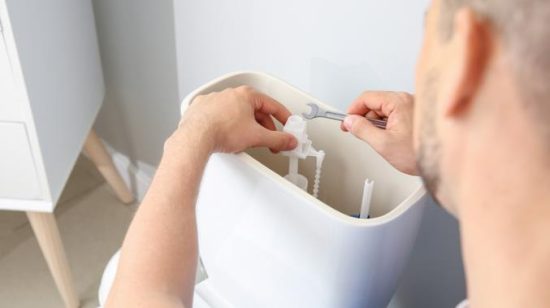Why Does My Toilet Keep Running? – A Troubleshooting Guide

A constantly running toilet is an irritation and a wasteful problem that may significantly increase your water cost. Any homeowner has to understand the causes of this as well as the solutions. This article will examine the exact causes why does my toilet keeps running and provide detailed guidance on the problem.
Understanding Your Toilet’s Mechanics
A thorough understanding of the various components and how they function is vital to addressing the issue of a continuously running toilet.
Here’s a detailed breakdown:
Flush Handle

This is the button or lever that you press to start a flush. It is immediately linked to the internal flushing system through a connector. The primary function of the handle is to act as a lever to control the flush. Pressing it causes a chain to pull, lifting the flapper at the tank’s base. Frequent inspections guarantee that the handle works smoothly and resists or sticks.
Chain and Flapper
A chain connects the flapper at the bottom of the tank to the flush handle. Water will flow from the flush tank into the bowl when the handle is squeezed, pulling the flapper up with the chain. This part is essential to seal the tank’s base to prevent water leaks. The flapper may cause misalignment with time, which frequently results in the widespread issue of a running toilet. It’s critical to look for wear or damage; if the flapper isn’t sealing correctly, replace it.
Flush Valve
The flapper lies over the flush valve, which is the hole at the bottom of the tank. It regulates the amount of water released during toilet flushes, and to stop water flow from continuing, it must close tightly after each flush. The main cause of a toilet that won’t stop running may be a malfunctioning flush valve that doesn’t close completely. Maintaining the quality and efficacy of the flush valve can be achieved by ensuring it is clear of dirt and debris. Frequent inspections can reduce water consumption and stop possible leaks.
Fill Valve
The fill valve adds water to the tank again after a flush has drained it. It has a mechanism that turns off the water when the tank fills to a predetermined level and is connected to your house’s water supply. Fill valve issues might result in overflow if the valve doesn’t close off when it should or if there is insufficient tank filling. If the water keeps running after the tank is full or if the tank is filling too slowly, adjustments may be required. Frequent maintenance keeps the fill valve functioning properly and guards against malfunctions that could cause the toilet to run.
Overflow Tube and Float Ball

By carefully channeling extra water into the bowl, the overflow tube keeps the water in the tank from overflowing. When the proper water level is reached, the float ball attached to the fill valve rises with the water level and tells the fill valve to stop filling. The fill valve may flow if the float ball is misaligned and misinterprets the water level. Ensure the float ball is at the right height to ensure optimal toilet function. Regular checks and adjustments help maintain the proper water levels and stop continuous running.
Identifying Signs of a Malfunctioning Toilet
Listen for the sound of intermittent or continuous water flow as the first step in detecting a running toilet. Additional indications include a toilet that flushes itself without being led or water that trickles down the edges of the bowl long after flushing. These signs point to problems with internal workings, usually related to the fill valve or flapper. Other signs of a problem include hearing hissing sounds from the toilet or noticing an increased water bill. Visual examinations can also show whether the water level in the toilet tank is excessive or whether the water keeps coming in. Regularly monitoring these indicators can help identify problems before they worsen and save water and money.
Why Does My Toilet Keep Running?
A running toilet is a frustrating issue and costly. Understanding the most common causes can help you diagnose and fix the problem efficiently. Here’s a detailed look at each issue:
Worn-Out Flapper
The flapper is an essential part of sealing the gap between the tank and the bowl. When the flapper’s rubber declines or warps with time, it can no longer create a tight seal and lets water seep into the bowl constantly. This ongoing leak may result in significant water waste. This problem can be avoided with routine flapper replacement and examination for wear indicators. To keep your toilet functioning properly, make sure the replacement flapper is the right size and kind.
How do I fix it?
- Inspect the Flapper: Remove the tank lid and inspect the flapper. Look for signs of wear, like cracks, warps, or discoloration.
- Replace the Flapper: If the flapper is damaged, replace it. Make sure to turn off the water supply to the toilet before starting. Flush the toilet to drain the tank. Disconnect the old flapper and attach the new one, ensuring it’s the correct size and type for your toilet model.
Chain Adjustment Issues

There is a chain that connects to the flush handle that must be adjusted correctly for the flapper to operate as intended. Leaks may occur if the flapper cannot sit properly due to an overly tight chain. On the other hand, if the chain is too loose, the flapper might not be raised to a level that permits a successful flush. Adjusting the chain to the proper length is an easy solution to many running toilet problems. For the chain to function properly, it must also be checked for kinks or tangles.
How do I fix it?
- Adjust the Chain Length: Check the chain length connecting the flapper to the flush handle. It should have just a little slack when the flapper is closed.
- Remove Kinks or Tangles: Straighten any kinks or tangles in the chain to ensure smooth operation.
Malfunctioning Fill Valve
After every flush, the fill valve controlls the amount of water that enters the toilet tank. Water will continuosly flow into the tank and down the overflow tube if the fill valve does not close when the tank is full. This can significantly raise your water cost and result in a running toilet. Stopping the constant flow of water requires replacing or fixing a broken fill valve. Cleaning the valve regularly is also a good idea to avoid any buildup hindering its functionality.
How do I fix it?
- Test the Fill Valve: Flush the toilet and observe if the fill valve shuts off when the tank is full. If it doesn’t, it might need adjustment or replacement.
- Replace or Repair the Fill Valve: Turn off the water supply and flush the toilet to empty the tank. Remove the old fill valve and install a new one following the manufacturer’s instructions.
Improperly Adjusted Float Ball
The water level in the toilet tank is managed by the float ball both during and after filling. The toilet will run if the setting is too high since the tank’s water level will rise above the overflow tube. Stopping the toilet from running and avoiding overflow can be done by adjusting the float to the proper height. It’s crucial to frequently examine the float’s adjustment and condition to ensure it operates correctly. This is often a simple, one-time modification to save water and quiet the noisy, continuously running toilet.
How do I fix it?
- Adjust the Float Ball: The float ball should not be touching any other parts inside the tank, and it should cut off the water at about an inch below the overflow tube.
- Bend the Float Arm: If necessary, carefully bend the float arm downward to lower the water level. Make sure it moves freely and stops the water at the correct level.
Deposits and Debris in Fill Valve

The fill valve may get clogged with debris and mineral deposits over time, making it impossible to close entirely and resulting in a running toilet. This problem can be avoided by regularly cleaning and maintaining the fill valve. It could be required to replace the valve if cleaning does not fix the issue. Mineral buildup is more widespread in locations with hard water, and this is especially common there. Putting in a water softening system can also aid in lowering the buildup of deposits in your toilet’s working parts.
How do I fix it?
- Clean the Fill Valve: Turn off the water and flush the toilet to drain the tank. Dismantle the fill valve and clean out any debris or mineral deposits using vinegar and a small brush.
- Consider Regular Maintenance: Install a water softening system if hard water is an issue, and periodically clean the fill valve and other toilet components to prevent future problems.
Conclusion
Addressing the problem of a running toilet alleviates annoyance and curtails wasteful water use, ultimately saving money. By understanding the mechanics of your toilet and regularly checking for signs of malfunction, you can effectively maintain your bathroom’s plumbing and ensure it operates efficiently. Should you encounter persistent issues, consider consulting a professional plumber to resolve the problem and prevent future complications.
FAQs on Why Does My Toilet Keep Running
1. Why does my toilet keep running even after flushing?
Several issues, including a faulty flapper, a maladjusted float, a malfunctioning fill valve, or debris in the valve system, can cause a running toilet. Checking each component for proper function and adjustment can resolve the issue.
2. How can I tell if my flapper needs replacing?
Inspect the flapper for signs of wear, such as cracks, warps, or decay. It should be replaced if the rubber looks damaged or doesn’t form a tight seal. You can try a dye test by adding food coloring to the tank; your flapper will leak if the color seeps into the bowl without flushing.
3. What should I do if adjusting the float doesn’t stop the toilet from running?
If adjusting the float does not resolve the running toilet, the issue may lie with the fill valve itself. It might fail to shut off properly due to internal wear or debris. Consider cleaning or replacing the fill valve.
4. Can a running toilet increase my water bill?
Yes, significantly. A running toilet can also waste hundreds of gallons of water daily, leading to a steep increase in water bills. Addressing the issue promptly can prevent unnecessary water usage and save money.
5. Is it difficult to replace the parts of the toilet myself?
Many toilet repairs, such as replacing the flapper, adjusting the chain, or swapping out the fill valve, can be done without professional help and require minimal tools. Plenty of DIY tutorials are available to guide you through the process. However, if you need more clarification or are uncomfortable performing these tasks, it’s wise to call a plumber.
